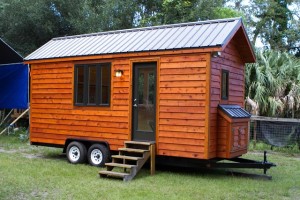April is a graduate student in English at the University of Oregon.
In this video she’s interviewed on her decision to live in a tiny house on wheels.
Oregon Student Living the Tiny Life
At 19’x8′ the home is just 130-square-feet including the sleeping loft.
It’s got a tiny covered porch and you walk right into the main room. It’s a classic Tumbleweed tiny house design.
Interview: April Anson on Living in a Tiny Home

Photo by Matt Cooper
She says it’s about 114 square feet but I don’t think that includes the loft. It’s 130 including that according to Tumbleweed’s plans.
Using Reclaimed Materials to Build Tiny AND Green
Everything except the studs, shingles, roof and interior walls came from recycled materials.
The flooring came from bleachers from an old gym! Pretty cool, huh?
Welcome to April’s Tumbleweed Tiny House…
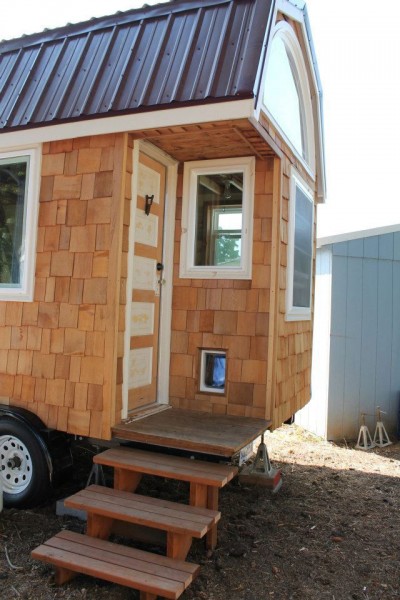
Photo Credits April Anson
Come on in! Join us for the complete photo tour (and video interview) below:
[continue reading…]
{ }
I got this email from one of our wonderful readers, Teri, who’s getting ready to build a Tumbleweed Fencl tiny house to live in.
She’s got a 95-year-old mother who is excited for her and they’d both love to get the chance to tour a little house preferably a Tumbleweed in the Los Angeles area.
So I thought I’d re-post her message here and ask if you might be able to help refer her to somewhere (or someone) that can help her.
Hi Alex,
Within the next couple of years I will be building a Tumbleweed Fencl to live in. My 95-year old mom supports my dream but she doesn’t really know what a tiny house looks like. I’d love to find someone in the greater Los Angeles, CA area who might be willing to share just a few minutes of their time to show my mom what my future little home will look like. I’ve posted my request on the Tiny House Map, but other than that do you have any ideas how I can get my message out to other Tiny Housers? Would this request merit a mention in your newsletter?
Thanks for your help!
Teri
Loving & Learning Center
Exceptional EduCare for Infants, Toddlers & Preschool
www.LovingAndLearningCenter.com
If you have any ideas or suggestions just leave them in the comments below or if you’d prefer to get in contact with Teri directly her email is terijane [AT] sonic dot NET (hope you can make that out, just trying to avoid spammers). Thank you so much!
{ }
Just a few days ago I received an email from my friend Ryan who blogs about tiny houses at The Tiny Life. He basically announced that after 3 and a half years of writing and talking about tiny homes that he is finally going to build one for himself to live in as his home. A mortgage-free home. So I decided to arrange a phone call to interview him that way you can get a glimpse into his thoughts and reasons for making this change and how he’s making it all work.
I’ve transcribed the interview for you to read below but I’ve also uploaded it to YouTube so you can listen to it there. In the near future, it will be available on iTunes as a podcast so that you can listen to it from your iPhone, iPad, iPod, PC, or Mac. I hope you enjoy it as much as I did!
Oh, and if you’re curious, he’s building and designing a slightly modified version of Tumbleweed’s Fencl design which looks like this:
Want more kind of like this? Join our FREE Small House Newsletter!

Photo Credit Tumbleweed Houses
I can’t wait to learn more about the house. But for now, enjoy the interview then if you want to leave your thoughts at the bottom of this page in the comments so we can all talk about it.
Listen to the entire interview or read the transcript below:
[continue reading…]
{ }
By Laura LaVoie
Before building a tiny house, the most home improvement work I had ever done was painting. But that was the draw of doing something that I had never done before. There were two of us, which made the process easier, but that doesn’t stop most tiny house builders from moving forward.
Our motivation was to build something by ourselves with our own hands. Since it took us so long to build our tiny house, each week would be a new and interesting project. We would spent time throughout the week learning how to build whatever was next. Was it post and pier foundations? Was it framing? Was it roofing? Was it insulation? Flooring? Siding? Windows? The list goes on and on.
Please don’t miss other exciting tiny homes – join our FREE Tiny House Newsletter!
I believe that the Do It Yourself spirit lives within most tiny house builders.
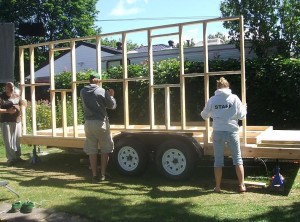
Photo Credit Collin and Joanna
I encourage you to read the rest of this article below:
[continue reading…]
{ }
Do you ever wonder how a tiny house is built strong enough to be towed without warping or incurring any type of damage due to strong winds? In our last webinar, we talked briefly about what’s known as Simpson Strong Ties. Also known as Seismic Strong Ties. They’re sometimes called Hurricane Ties too. You use these in stick built structures to help make them stronger, especially useful for the trusses, rafters, and studs on little homes on trailers. These genius ties make building your dwelling easier and way stronger than they’d normally be without them.
To learn more about Seismic Strong Tie Connectors click here. If you want to place an order for some strong ties for your construction project, see the links below:
Please don’t miss other exciting tiny homes – join our FREE Tiny House Newsletter!

Photo Credit Tumbleweed Houses
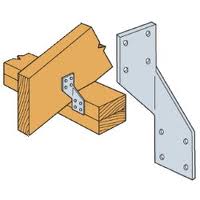
Photo Credit Simpson Strong Ties
You can also get these in packs of 100 right here.
[continue reading…]
{ }
Have you met Collin and Joanna before? They’re a young couple who built and lived in their own Tumbleweed Fencl tiny house on a trailer. They bought the plans, ordered the trailer, built the house, and moved in!
But now they’re very happy to announce that they’re starting a family so they will be upsizing to a home that will be better for them to raise a child in. So that means their gorgeous little house is up for sale. The tiny house has sold but you can still see it below!
This is one of the most elegantly designed tiny houses that I’ve seen to date. They used Jay Shafer’s Tumbleweed Fencl building plans to build it and they did an excellent job of decorating as you’ll see in the pictures.
It’s a 130-square-foot design meant to be built onto a 7’x18′ trailer. To date, we’ve featured numerous builds that have used the same plans which you can check out at the bottom of this page.
So yes – the Fencl is definitely a popular tiny home design to build and live in. So, without further adieu, here’s Collin & Joanna’s beautiful self-built tiny home…
Please don’t miss other exciting tiny homes – join our FREE Tiny House Newsletter!
Collin and Joanna’s Beautiful Self-built Tumbleweed Fencl Tiny House
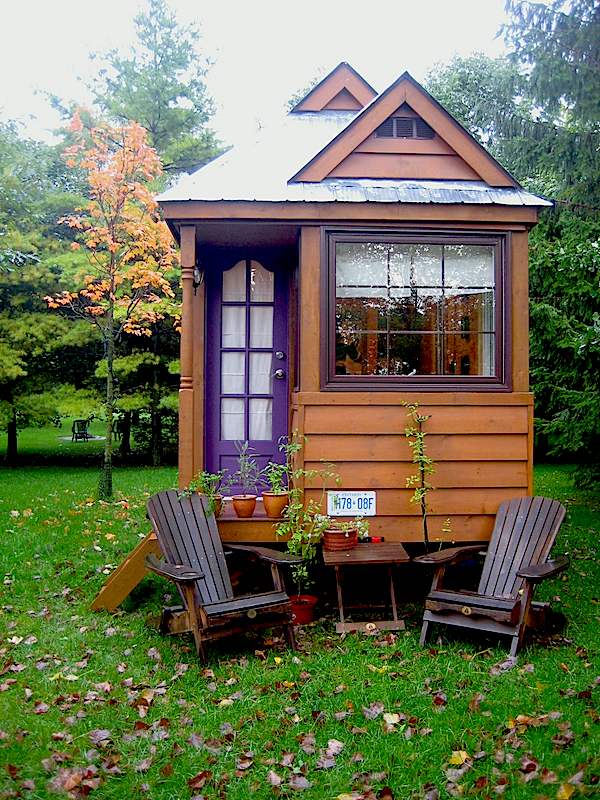
Photo Credit OurWeeHouse.com
Luscious, isn’t it? Wait until you go inside.. They spared no expense when it came to making this a lovely home to live in.
[continue reading…]
{ }
Article by Laura LaVoie
What is the permanence of the tiny house living? Do people move into tiny spaces and live there for the rest of their lives? Since the movement is still rather young I imagine that we have not yet reached that moment of maturity when the first generation of tiny dwellers begins to consider their next move. I was certain that stories had to be out there of people who made the decision to leave tiny behind so I searched and found three tiny house builders who made the decision to move.
Almost a year ago Zoey from Living Tiny 365 posted that after some changes in her life she was moving from her Lusby into a condo with her new partner. The condo, she said, was still small at 700 square feet and that her daughter was planning to move into the tiny house. I reached out to Zoey to find out more about her life since the decision to move out of her tiny house but I have not yet heard from her. Zoey, we would love to hear the next chapter in your story so please reach out if you see this.
Please don’t miss other exciting tiny homes – join our FREE Tiny House Newsletter!

Photo Credit Zoey, http://www.livetiny365.com/
[continue reading…]
{ }
In this video-based post, you’re going to learn the basics of how to floor and frame a Tumbleweed tiny house on a trailer. In this video, they are building the Fencl tiny house using an 18′ trailer. The design shown here is 130 square feet without including the upstairs sleeping loft and the tiny front porch area.
Designed by Jay Shafer, the original designer at Tumbleweed Houses (today he’s at Four Lights). his video (below) is going to show you the basics of flooring and framing a tiny house on wheels.
Please don’t miss other exciting tiny homes – join our FREE Tiny House Newsletter!
How to Build a THOW (Tiny House on Wheels)

Photo Credit Tumbleweed Houses/YouTube
The steps outlined below are assuming that you have already decided on a design (either your own or set of plans) and are therefore ready to buy a trailer.
How to Floor and Frame a Tumbleweed Tiny House on a Trailer
Step 1. Buy your trailer, materials, and order your windows
[continue reading…]
{ }
You probably have never heard of the Mulfinger tiny house before. It’s one of Jay Shafer’s old Tumbleweed tiny house designs, but it’s no longer available. The design is simple and elegant, like all of Jay’s work.
You are greeted with a porch and everything is perfectly symmetrical. Since this home is not on a trailer, it’s wider and therefore much more spacious. Once you walk in the kitchenette is to your left and table to your right. The ceilings are vaulted so it feels light, bright, and open. The windows really help with this effect too.
Please don’t miss other exciting tiny homes – join our FREE Tiny House Newsletter!
Mulfinger Tiny Cottage

Photos Courtesy of Mark Terrano
[continue reading…]
{ }














